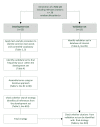Routine development of objectively derived search strategies
- PMID: 22587829
- PMCID: PMC3351720
- DOI: 10.1186/2046-4053-1-19
Routine development of objectively derived search strategies
Abstract
Background: Over the past few years, information retrieval has become more and more professionalized, and information specialists are considered full members of a research team conducting systematic reviews. Research groups preparing systematic reviews and clinical practice guidelines have been the driving force in the development of search strategies, but open questions remain regarding the transparency of the development process and the available resources. An empirically guided approach to the development of a search strategy provides a way to increase transparency and efficiency.
Methods: Our aim in this paper is to describe the empirically guided development process for search strategies as applied by the German Institute for Quality and Efficiency in Health Care (Institut für Qualität und Wirtschaftlichkeit im Gesundheitswesen, or "IQWiG"). This strategy consists of the following steps: generation of a test set, as well as the development, validation and standardized documentation of the search strategy.
Results: We illustrate our approach by means of an example, that is, a search for literature on brachytherapy in patients with prostate cancer. For this purpose, a test set was generated, including a total of 38 references from 3 systematic reviews. The development set for the generation of the strategy included 25 references. After application of textual analytic procedures, a strategy was developed that included all references in the development set. To test the search strategy on an independent set of references, the remaining 13 references in the test set (the validation set) were used. The validation set was also completely identified.
Discussion: Our conclusion is that an objectively derived approach similar to that used in search filter development is a feasible way to develop and validate reliable search strategies. Besides creating high-quality strategies, the widespread application of this approach will result in a substantial increase in the transparency of the development process of search strategies.
Figures
Similar articles
-
Retrieval of overviews of systematic reviews in MEDLINE was improved by the development of an objectively derived and validated search strategy.J Clin Epidemiol. 2016 Jun;74:107-18. doi: 10.1016/j.jclinepi.2015.12.002. Epub 2015 Dec 23. J Clin Epidemiol. 2016. PMID: 26723872
-
Assessing the performance of methodological search filters to improve the efficiency of evidence information retrieval: five literature reviews and a qualitative study.Health Technol Assess. 2017 Nov;21(69):1-148. doi: 10.3310/hta21690. Health Technol Assess. 2017. PMID: 29188764 Free PMC article.
-
The future of Cochrane Neonatal.Early Hum Dev. 2020 Nov;150:105191. doi: 10.1016/j.earlhumdev.2020.105191. Epub 2020 Sep 12. Early Hum Dev. 2020. PMID: 33036834
-
An evidence-based practice guideline for the peer review of electronic search strategies.J Clin Epidemiol. 2009 Sep;62(9):944-52. doi: 10.1016/j.jclinepi.2008.10.012. Epub 2009 Feb 20. J Clin Epidemiol. 2009. PMID: 19230612 Review.
-
A comparison of results of empirical studies of supplementary search techniques and recommendations in review methodology handbooks: a methodological review.Syst Rev. 2017 Nov 28;6(1):234. doi: 10.1186/s13643-017-0625-1. Syst Rev. 2017. PMID: 29179733 Free PMC article. Review.
Cited by
-
OvidSP Medline-to-PubMed search filter translation: a methodology for extending search filter range to include PubMed's unique content.BMC Med Res Methodol. 2013 Jul 2;13:86. doi: 10.1186/1471-2288-13-86. BMC Med Res Methodol. 2013. PMID: 23819658 Free PMC article.
-
Protocol for a systematic review of N-of-1 trial protocol guidelines and protocol reporting guidelines.Syst Rev. 2017 Jul 6;6(1):132. doi: 10.1186/s13643-017-0525-4. Syst Rev. 2017. PMID: 28679407 Free PMC article.
-
Design and implementation of Metta, a metasearch engine for biomedical literature retrieval intended for systematic reviewers.Health Inf Sci Syst. 2014 Jan 10;2:1. doi: 10.1186/2047-2501-2-1. eCollection 2014. Health Inf Sci Syst. 2014. PMID: 25825665 Free PMC article.
-
Development and validation of paired MEDLINE and Embase search filters for cost-utility studies.BMC Med Res Methodol. 2022 Dec 3;22(1):310. doi: 10.1186/s12874-022-01796-2. BMC Med Res Methodol. 2022. PMID: 36463100 Free PMC article.
-
Meeting a need: development and validation of PubMed search filters for immigrant populations.J Med Libr Assoc. 2024 Jan 16;112(1):22-32. doi: 10.5195/jmla.2024.1716. J Med Libr Assoc. 2024. PMID: 38911528 Free PMC article.
References
-
- Lefebvre C, Manheimer E, Glanville J. In: Cochrane Handbook for Systematic Reviews of Interventions. Higgins JPT, Green S, editor. New York: Wiley; 2008. Searching for studies; pp. 95–150.
MeSH terms
LinkOut - more resources
Full Text Sources
Miscellaneous


